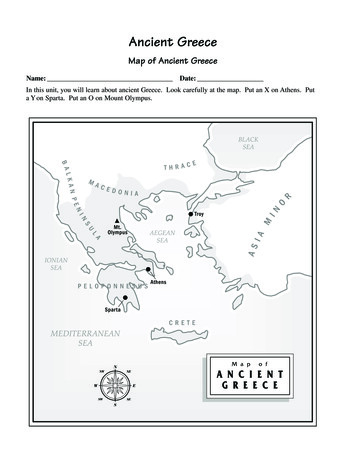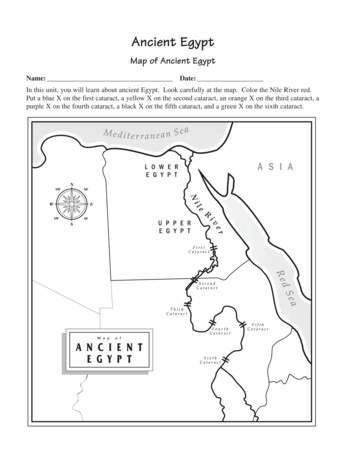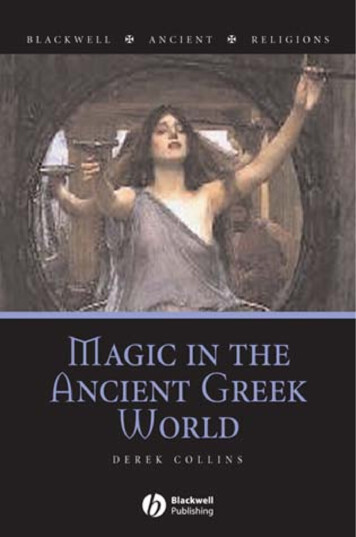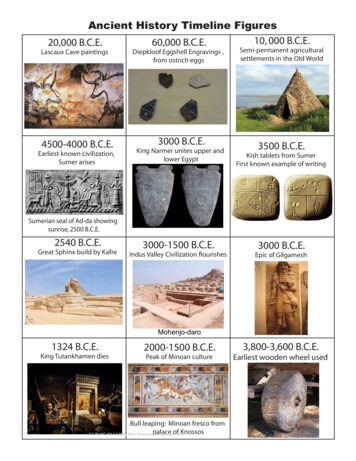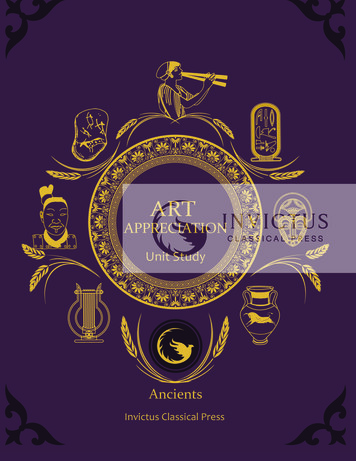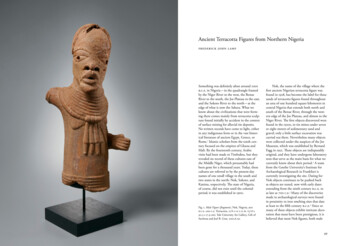
Transcription
Ancient Terracotta Figures from Northern Nigeriafrederick john lampSomething was definitely afoot around 1000b.c.e. in Nigeria—in the quadrangle framedby the Niger River to the west, the BenueRiver to the south, the Jos Plateau to the east,and the Sokoto River to the north—at theedge of what is now the Sahara. What weknow about the civilizations that were forming there comes mainly from terracotta sculpture found initially by accident in the contextof surface mining for alluvial tin deposits.No written records have come to light, eitherin any indigenous form or in the vast histor ical literature of ancient Egypt, Greece, orRome.1 Islamic scholars from the tenth century focused on the empires of Ghana andMali. By the fourteenth century, Arabicvisits had been made to Timbuktu, but theyrevealed no record of these cultures east ofthe Middle Niger, which presumably hadbeen gone for a thousand years. Today, thesecultures are referred to by the present-daynames of one small village in the south andtwo states in the north: Nok, Sokoto, andKatsina, respectively. The state of Nigeria,of course, did not exist until the colonialperiod; it was established in 1900.Fig. 1. Male Figure (fragment), Nok, Nigeria, 900b.c.e.–500 c.e. Terracotta, 22¾ x 12 x 11 in. (57.8 x30.5 x 27.9 cm). Yale University Art Gallery, Gift ofSusAnna and Joel B. Grae, 2010.6.13248Nok, the name of the village where thefirst ancient Nigerian terracotta figure wasfound in 1928, has become the label for thousands of terracotta figures found throughoutan area of one hundred square kilometers incentral Nigeria that extends both north andsouth of the Benue River, through the western edge of the Jos Plateau, and almost to theNiger River. The first objects discovered werefound in the 1920s, in tin mines under sevenor eight meters of sedimentary sand andgravel; only a little surface excavation wascarried out there. Nevertheless many objectswere collected under the auspices of the JosMuseum, which was established by BernardFagg in 1952. These objects are indisputablyoriginal, and they have undergone laboratorytests that serve as the main basis for what wecurrently know about their period.2 A teamfrom the Goethe University’s Institute forArchaeological Research in Frankfurt iscurrently investigating the site. Dating forNok objects continues to be pushed backas objects are tested, now with early datesextending from the ninth century b.c.e. toas late as 700 c.e.3 Many of the discoveriesmade in archaeological surveys were foundin proximity to iron smelting sites that dateat least to the fifth century b.c.e.4 Since somany of these objects exhibit intricate decoration that must have been prestigious, it isbelieved that most Nok figures, both male49
and female, represent important politicalleaders. Other Nok sculptural subjectsinclude disease and animals such as monkeys,bats, felines, elephants, snakes, and possiblyrams. Almost all terracotta figurines havebeen found broken, suggesting a ritual process of destruction.5Characteristic features of the Nok styleare outlined, semicircular, pierced eyes; openmouths; and elaborate braided and bunnedcoiffure for both male and female figures.Several styles of Nok facial features have beendistinguished, and all these styles are foundthroughout the region of discovery, suggesting that they do not represent regionalaesthetics, but rather indicate some otherdistinction, perhaps schools of fabricationthat had wide distribution. The consistencyof these artistic conventions, lasting morethan a thousand years, suggests a kind ofcentralization of this society, in which ideaswere shared widely and agreed on.6 Theobjects with the earliest dates are of fullymatured fluorescence, suggesting that theperiod of artistic activity in question beganmuch earlier, and that the period of habitation and civilization of these people beganbefore that. But to locate these dates withany specificity, we will need to wait for theresults of the archaeological excavationsstill under way.Sokoto State is in northwest Nigeria inthe Niger River Valley, at the confluence ofancient trade routes. Little is known of theancient culture, as there has been no controlled archaeological investigation. BayardRustin, the civil rights leader of the 1950s and1960s who originally collected most of theYale University Art Gallery’s ancient terracotta figures in Nigeria, reported that “theSokoto and Katsina pieces were found inlarge man-made mounds.”7 From scientificdating, the culture appears roughly contemporary with Nok to the south, suggesting aperiod from 500 b.c.e. to 200 c.e. Character istic of Sokoto features are heavy eyebrowsand beards, the latter sometimes braided orbound. Generally these figures are fragmen-50tary, with only the bust remaining, and theheads are often life-sized or even larger thanlife. How large the full figures would havebeen is difficult to say—presumably the common West African proportion of one to threeor four (the relation of the head to the body)would have prevailed, but even if this is thecase, many of these full figures would havebeen enormous.Katsina State is on the trade routesbetween the ancient city of Kano and theSahara. It is closely linked with Sokoto,and terracotta objects coming from theseareas without provenance are difficult toattribute precisely to one state or the other.Furthermore the dating of these objects isencumbered by the fact that no controlledarchaeological excavations have been carriedout. A period of three hundred years, from200 b.c.e. to 100 c.e., has been suggested,but this is guesswork based on a very sparsesample, with no stratigraphy on which torely. It seems that most figures from Katsinawere originally attached to the top of globular jars and were perhaps funerary markers.Figures commonly are seated with hands resting on the knees and faces that are relativelynaturalistic, with caps on the head.The works of these three areas, whilesuggesting distinct polities, also bear manysimilarities. Nok, Sokoto, and Katsina allproduced very large, hollow, thin-walled,low-fired, terracotta human sculptures insimilar postures and bearing like ornamentation, many with heads close to life-sized. Themedium used throughout is earthenwaremixed with quartz and mica for tenacity, surfaced with a slip of ocher or mica schist andburnished with a smooth pebble to achieve afine finish.8 Quite a few sculptures from eachof these groups share stylistic similarities. Wehave a vague idea of the limits of the Nokgeographical area, but we have very little ideaabout ancient Sokoto and Katsina, where nocollection data has been recorded. The cultures probably overlapped geographically, atleast in part, and certainly were known toeach other at particular times.A collection of sixty-four figural sculptures from these cultures of ancient Nigeriawas given to the Gallery in 2010, as part of adonation of 243 objects from SusAnna andJoel B. Grae. Other sculptures in terracottaand stone represent the somewhat later culture of Bura, which was located further upthe Niger River in present-day Niger. Mostof these objects were in fragments that werereassembled with no attempt at restorationor camouflage, as is common in other col lections. The Graes wanted no deceptionthat would interfere with the possibility ofresearch. Rustin field-collected the objectspersonally in northern Nigerian villages inthe 1950s and 1960s during his visits toNnamdi Azikiwe, who became presidentof Nigeria at independence.One of the most fascinating and largestfigures in the collection of Nok terracottasis a male torso with a bearded head turnedslightly to its right, its right arm (now lost)seemingly once uplifted, as if it were inthe act of hurling a spear (fig. 1). Multiplestrands of necklace beads are depicted aroundthe neck and shoulders and covering theupper chest above sagging pectorals; fromthese strands, four long tubular ornaments,possibly representing iron bells, are suspended. Around the waist are more strandsof beads, and although what was below thewaist is now lost, it probably displayed moreornamentation, including a breechclout orpenis sheath, as is commonly found in similar works. Around the proper left side of thefigure, hanging from the right shoulder, arewhat seem to be strands of fiber or leatherforming a strap from which are suspendedthree small containers, possibly meant tohold medicine, as one sees in later West African sculptures. Elaborate ornamental bandsare found around the left arm at the shoulder, the elbow, and the wrist. The figure mayrepresent a military leader—one is temptedto say a king—but we have no idea about thepolitical system that was in force.9Another Nok sculpture represents a malefigure with his hands upraised, the fingers,Fig. 2. Male Figure with Arms Upraised, Nok, Nigeria,900 b.c.e.–500 c.e. Terracotta, 21½ x 7 x 7 in. (54.6 x17.8 x 17.8 cm). Yale University Art Gallery, Gift ofSusAnna and Joel B. Grae, 2010.6.11451
delicately rendered, touching above the head(fig. 2). The pectorals are again represented.Around the neck is a single band, and somesort of packet hangs from the proper leftshoulder. Around the waist is another singleband, tied in front, and a long, decorativepenis sheath is tied with multiple bands atthe top. The face is exquisitely rendered withfull lips slightly parted, large circular eyeswith heavy eyelids, and a prominent, archedbrow. What could this elegantly attired person be doing, in a gesture that, with no cultural clues, we might interpret as reverential?This may be the only example of such a figural posture in the corpus of Nok objectspublished to date.A seated male figure from Katsina mayhave originally been built atop a globularvessel, which would have constituted a verylarge object (fig. 3). The bearded figure,apparently squatting, and nude, rests hishands on his knees, one higher than theother. He is decorated with a band aroundthe neck, and multiple bands on the wrists,knees, and ankles and around the back ofthe waist. His facial expression resembles theone on a bust of a figure from Sokoto thatis impressive in both its size and its boldnessof features (fig. 4).The Sokoto figure is a bearded and mustached male, with hair dressed elaborately ina profusion of vertical projectiles and witha braided band along the forehead. He isfurther decorated with a necklace with multiple striated pendants, resembling feathers.The hands rest against the chest, and in theproper right hand is what seems to be a flailwrapped over the shoulder. The presence ofthe flail, an insigne of authority that is commonly seen throughout West and CentralAfrica, would seem to indicate that this isthe representation of a political leader.In the known corpus of both Nok andSokoto works, there are numerous suggestions of visual affinities with another culturein Africa, which overlapped in time withthese Nigerian cultures, though it has beendocumented as being of much greater antiq-52uity—that of ancient Egypt. If we may takethe earliest reaches of these Nigerian civil izations as a group to extend through thefirst millennium b.c.e., and possibly furtherback, they would be contemporaneous with aperiod of the Egyptian civilization beginningat the end of the New Kingdom, from thelate dynasties of the Third IntermediatePeriod (including the Kushite dynasty ofNubia), and extending through the Romanperiod. I would like to suggest not that Egyptians and the people of ancient Nigeria necessarily knew each other, or had direct contact,but that a pan-Saharan set of conventionsmay have spread along the trade routes.Far from posing as a barrier, the Saharahas been a maze of highways for commercialcontact between the North African coast andthe West African minefields for thousandsof years.10 Deserts and bodies of water aremuch more penetrable than forests and jungles, which bear the challenges of mountainranges and chasms, not to mention hostileforces, both two-legged and four-legged.Some of the most well-known routes ranbetween Niani, in current-day Guinea, andTimbuktu; Timbuktu and Fez; Gao and thearea of current-day Benghazi and Tripoli; andFez and Cairo. These were all documentedby the eighth century. Did they exist onethousand years earlier? From the beginningof dynastic Egypt, five thousand years ago,routes led five hundred kilometers fromAkhmim on the middle Nile to the DakhlaOasis, and more than six hundred kilometersfrom Aswan to the Selima Oasis, and thenbeyond to the southwest.11 It has been suggested that both copper and tin were exportedfrom the Nok area to as far as Egypt as earlyas the second millennium b.c.e.12 We knowfrom the depictions at Saharan sites such asTassili n’Ajjer at the Algeria–Niger borderand Oualata-Tichitt in Mauritania, not farfrom Timbuktu, that cattle were herdedacross vast areas as early as 2000 b.c.e. andthat the horse (before 1000 b.c.e.) and thenthe camel (c. 400 b.c.e.) were introduced bythe next millennium (although we do notFig. 3. Male Figure, Katsina, Nigeria, 200 b.c.e.–100 c.e. Terracotta, 26½ x 7¾ x 8 in. (67.3 x 19.7 x20.3 cm). Yale University Art Gallery, Gift of SusAnnaand Joel B. Grae, 2010.6.109Fig. 4. Male Figure (fragment), Sokoto, Nigeria,500 b.c.e.–200 c.e. Terracotta, 18 x 11½ x 10½ in.(45.7 x 29.2 x 26.7 cm). Yale University Art Gallery,Gift of SusAnna and Joel B. Grae, 2010.6.15253
know when they reached West Africa).13 Ifcamels were at Tassili in the fourth centuryb.c.e., they were clearly traveling south;travel, not animal husbandry, was their raisond’être. Today the Tuareg traverse the entireSahara on camel caravans, following a tradition known for millennia. One of the mostfamous journeys, chronicled by the Arabs,was the trip by the emperor of ancient Mali,Mansa Moussa, from Timbuktu, in presentday Mali on the Niger River, through Alexandria (where he was said to have crashedthe market with his abundance of gold), andall the way to Mecca in 1324. There musthave been many precedents for such a voyagefor the king to have attempted it. NorthernNigeria would have been mid-route betweenNiani and the Nile. Ancient migrations,however, would have been primarily pedestrian, and it should be noted that a camelcaravan does not travel much faster thana human caravan, although it enables thetransport of heavier cargo. Most travelers,of course, would have traded between intermediate sites, with goods passed along fromtrader to trader, along with stories and ideas.14In fact, possible routes can be tracedfrom northern Nigeria to the Nile that donot traverse the Sahara. It is 2,500 kilometersas the crow flies. Suzanne Blier has shownevidence of a forty-day trek from LowerNiger sites through Lake Chad and Darfur tothe Nile in Lower Nubia.15 Furthermore, onecan travel almost the entire distance by water,with rivers that connect, or closely reach eachother, during the rainy season and sometimesflow the opposite way. The Benue River is anexample, reversing and reaching Lake Chadat certain times of the year. The source ofthe Sokoto River nearly touches that of theHadejia River, which flows into the Komadugu Yobe River and then into Lake Chad.From here, continuous waterways (theErguig, Bahr Bola, and Bahr Azum rivers)flow to Darfur, from which caravan routeswent all the way to Kerma in Lower Nubia.Alternatively, additional seasonal waterways,such as the Wadi Howar and the Wadi al54Malik, could be connected to arrive atNapata, at the fourth cataract of the Nile.Beads travel enormous distances veryquickly, as witnessed at both Djenné, in Mali,and at Nok, where Egyptian faience has beenfound in excavation.16 Ideas travel quicklytoo, and ideas about conventions lead toideas about forms and to forms themselves.Many of the formal affinities between ancientEgypt and modern Africa may be the resultof more regional invention based on independently evolved ideas about space, utility,form, and ornament. But some forms mayhave followed ideas that traveled the routesof trade, religious missions, or migration,from one end of the continent to the other.The relationship of Egypt to the rest ofthe African continent is becoming of moreinterest to scholars than it has been in thepast. Most Egyptologists now acknowledgethat ancient Egypt was a crossroads betweenBlack Africa and the Near East. It is generallyassumed that with the final desiccation of theSahara about 4000 b.c.e., a movement ofpeoples began toward the Nile. Many comparisons have been made between the rockart and pottery of the early Sahara and theimagery of ancient Egyptian art.17As I have indicated, the Nok civilizationwas contemporary with the final millenniumof dynastic Egypt. A number of comparisonscan be made with Egyptian conventions,although we have no cultural context andthus no sure interpretation of the forms.Many Nok figures are depicted with elaborate necklaces of multiple strands, probablyrepresenting beaded collars of the type thatwere a prominent feature of royal Egyptiandress. The shepherd’s crook and the flailwere the principal emblems of kingship inancient Egypt and they are found, sometimestogether, sometimes singly, on terracotta figures from Nok and Sokoto. In these instances,the figures carry them in a way similar to thatseen in Egyptian sculpture. (In ancient Egyptthey are crossed at the figure’s chest and fallin front of the shoulders; in ancient Nigeria,they are tossed over each shoulder.) Somefigures carry an axe over the shoulder, resembling a practice among the Dogon of Malitoday, both in life and as depicted in theirsculpture. The penis sheaths worn by kingsand gods are also similar in the Egyptianand the Nok and Sokoto cultures, depictedas long cloth tubes tied with elaboratebows.18 Additionally, many figures from Nok,Sokoto, and Katsina depict a male wearing along beard that has been bound or braidedinto a single column. Braided and boundbeards have symbolized kingship throughoutAfrica, as they did in ancient Egypt. Not onlyforms but also iconography seem to havebeen shared across the Sahara. A perchingbird figure from Nok with a human faceresembles figures from dynastic Egypt, as wellas from later Nubian sites, representing anaspect of the human soul, ba, which couldmove back and forth from the dead body.A curious circle on the forehead of someNok heads recalls the sun sign of ancientEgypt, and one that, in fact, in Ghana todayis worn on the forehead as a symbol of thesoul. Certain conventions that we find bothon the Nile and on the southern border ofthe central Sahara may have enjoyed a broaddistribution, origin unknown.Who are the descendents and heirs ofthese cultures at the border of the Sahara thatseem to have disappeared after the fifth orsixth century? A number of cultural groupsin the region today might be candidates:among others, the Dakakari, the Jukun, oreven the Yoruba of southern Nigeria and theRepublic of Benin, all of which show someaffinity artistically with these earlier cultures.Today, northern Nigeria is dominated by theHausa and the Fulani, both relatively newimmigrants to the area, Islamized for centuries, and unsympathetic to figural sculpture.After two thousand years, the heirs of Nok,Sokoto, and Katsina would be spread verywidely, even to New York City and aroundthe globe.Since 2006 the Gallery has received alarge number of gifts of African antiquitiescreated prior to European contact, includingseveral objects from the Sapi of Sierra Leoneand many objects of sculpture, pottery, jewelry, and tools from the Inland Niger Deltain Mali; Bura in Niger; Koma in Ghana;and Nok, Sokoto, and Katsina in Nigeria.Together with Professor Roderick McIntosh,of Yale’s Department of Anthropology andCurator of Anthropology at the PeabodyMuseum, we have collaborated in bringingthis collection to Yale, and we have begunusing the collection in several ways witharchaeology classes. As one of the foremostarchaeologists working in Africa, McIntoshhas been a champion for honesty and ethicsin the collecting of African antiquities. Weagreed that of all the possible dispositions ofthis collection, already long in private hands,the acquisition by Yale, and its disclosureinternationally through widespread publication, would be the best option. A smallercollection of African antiquities came withthe gift of Charles Benenson, b.a. 1933. Theantiquities have been given prominent display in the African gallery, with more thanfifty objects on view.Those of us who have studied Africanarchaeology are concerned about the issues ofcollecting, displaying, and studying the vastbody of material that has come out of Africaundocumented, without the benefit of thearchaeological context. Archaeological workis hindered by many factors in Africa, including the recalcitrance of local African governments, an inhospitable climate, prohibitivelocal customs, a lack of funding in the West,and a paucity of students. Until we havemore controlled archaeological excavationthroughout the continent of Africa, the periods discussed here—from the rise of ancientEgypt to the development of civilizationsin the area of the Niger River—will largelyremain subject to speculation. Uncontrolled,illicit excavation by local, amateur diggersdestroys the context of the objects’ stratigraphy, dating, use, and association with otherartifacts, which can provide informationabout the people who produced these cultural objects. Objects are damaged in careless55
digging, but there has also been the deliberate smashing of terracotta sculptures by localpeople suspicious of the dark powers theseartifacts might bear.19 The flooding of themarket with Nok figures has been complicated by diverse and ingenious methods offorgery, including the construction of wholefigures around an original fragment, majorrestoration of the surface and body parts, thejoining of unrelated body parts, and manyother tricks, all meant to satisfy a relentlessinternational demand. Thermoluminescencetests on such objects have inaccurately conferred authenticity.Recognizing the critical importanceof controlled excavation, Yale University’sinvolvement in archaeology in Africa hasbeen extensive, beginning with Nubia from1961 through 1963, led by William KellySimpson, in collaboration with the University of Pennsylvania Museum of Archaeologyand Anthropology. This resulted in a significant Nubian collection at the Yale PeabodyMuseum of Natural History. Most recently,McIntosh has been working with colleaguesin Mali at the site of Djenné on major excavations that began in 1977 and continuetoday. Additionally, Yale archaeology studentsare currently excavating early urban centersin the area of Timbuktu in what is now theSahara Desert, with discoveries that willoverturn our current understanding of theantiquity of Africa.The Graes, who have supported archaeological work in the Negev, collected Africanart already in the United States, beginningin the early 1970s, in the hope of depositingthese important documents in museums thatwould promote their active study. As JoelGrae has frequently said, “If you go to mostmuseums, you get the impression that Africahad no art before the nineteenth or twentiethcentury.” It is the wish of the Graes, andof the Gallery, that the collection be usedto educate the public about African art, theimportance of archaeological excavation, andthe untold wealth of the African heritage thatis also our own.561. The Cyrenean geographer Herodotus, who gavethe earliest reference to Ifriquiya, in the fifth centuryb.c.e., knew something of Nubia on the Upper Nileand the Garamantes of the Fezzan in southern Libya,but nothing of the area south of the Sahara. Romanarmies clearly reached the Fezzan, and it has been suggested that they crossed the Sahara, but no documentation indicates they had any knowledge of the Sahel.See Sir Harry H. Johnston, A History of the Colonization of Africa by Alien Races (Cambridge: CambridgeUniversity Press, 1899), 48; and Labelle Prussin,Hatumere: Islamic Design in West Africa (Berkeley,Calif.: University of California Press, 1986), 7.2. See Bernard Fagg, Nok Terracottas (London: Ethnographica, 1990), for a large corpus.3. Yashim Isa Bitiyong, “Culture Nok, Nigeria,” inVallées du Niger (Paris: Musée National des Artsd’Afrique et d’Océanie, 1993), 393–415; J. F. Jemkur,Aspects of the Nok Culture (Zaria: Amadu Bello University, 1992), 69; Ekpo Eyo and Frank Willett, Treasuresof Ancient Nigeria (New York: Alfred A. Knopf, 1980),57–64. Objects’ testing dates after 300 c.e. tend to besomewhat aberrant in style.4. Jemkur, Aspects of the Nok Culture, 64.5. Nicole Rupp, Peter Breunig, and Stefanie Kahlheber,“Exploring the Nok Enigma,” Antiquity 82 (2008): 313.6. Bitiyong, “Culture Nok, Nigeria,” 398–407.7. Reported in a letter from Wayne Cancro (dealer) toJoel B. Grae, July 12, 2004 (curatorial archives, Gift ofSusAnna and Joel B. Grae, Department of African Art,Yale University Art Gallery).8. Fagg, Nok Terracottas, 21.9. This figure had been in the Grae collection for manyyears, with the head in numerous fragments. In consultation between the conservator, Carol Snow, andme, the decision was made to reassemble the fragmentswith a reversible acrylic adhesive. Polyethylene foamstructural supports, toned with acrylic and gouachepaints, were positioned on each side of the head tosuspend the fragments of coiffure in place abovethe face.14. It should be acknowledged that both J. F. Jemkurand Peter Breunig reject the idea of influence fromEgypt or North Africa on Nok culture, in favor ofindependent invention. Jemkur, Aspects of the NokCulture, 64; Breunig, quoted in Matthias Schulz,“German Archaeologists Labor to Solve Mystery of theNok,” Spiegel Online, Aug. 21, 2009, 2521.00.html(accessed Feb. 26, 2010). I would argue thatcompletely independent invention does not exist.Nevertheless, other cross-fertilization might havebeen at play.15. Suzanne Preston Blier, “The Forty-Day TradeRoute: Ife, Benue, and the Nile c. 1300,” Mar. 2011,unpublished paper, Fifteenth Triennial Symposium onAfrican Art, University of California, Los Angeles.16. Susan K. McIntosh and Roderick J. McIntosh,“The Inland Niger Delta before the Empire of Mali:Evidence from Jenne-Jeno,” Journal of African History22 (1981): 1–22; Lois Sherr Dubin, The History of Beads(New York: Abrams, 1987), 125.17. Andrew B. Smith, “Desert Solitude: The Evolutionof Ideologies among Pastoralists and Hunter-Gatherersin Arid North Africa,” in Desert Peoples: ArchaeologicalPerspectives, ed. Peter Veth, Mike Smith, and PeterHiscock (Oxford: Blackwell, 2005), 272–73: “The vastlandscape of the Sahara allowed cultural contact fromMali to the Nile Valley as far back as 9,000 years ago.There appear to have been no barriers to movement,and even political entities which may have grownup did not deter culture transmission. . . . The distribution of wavy-line pottery ca. 9,000 bp is virtuallythe same as that of diamond rocker-stamped waresca. 6,000 bp . . . of Niger.”18. Edna R. Russmann and David Finn, EgyptianSculpture: Cairo and Luxor (Austin: University of TexasPress, 1989), 95–97.19. Fagg, Nok Terracottas, 18.10. Prussin, Hatumere, 8.11. Regine Schulz and Matthias Seidel, Egypt: TheWorld of the Pharaohs (Cologne: Könemann Verlagsgesellschaft, 1998).12. Bitiyong, “Culture Nok, Nigeria,” 409.13. Jemkur, Aspects of the Nok Culture, 62.57
Yale University Art Gallery's ancient terra-cotta figures in Nigeria, reported that "the Sokoto and Katsina pieces were found in large man-made mounds."7 From scientific dating, the culture appears roughly contem-porary with Nok to the south, suggesting a period from 500 b.c.e. to 200 c.e. Character-istic of Sokoto features are heavy eyebrows

